Last Updated: June 7, 2024
Most people visiting Costa Rica want to see a sloth. These adorable creatures are native to Costa Rica but only live in certain regions. Even in those places where it is possible to see one, you may only catch a glimpse from a distance. In this post, we’ll tell you where you can get an up-close view. The Sloth Sanctuary at Selvatura Park in Monteverde has a giant enclosure with almost 20 sloths roaming around inside. Below, we’ll tell you more about visiting and what to expect.
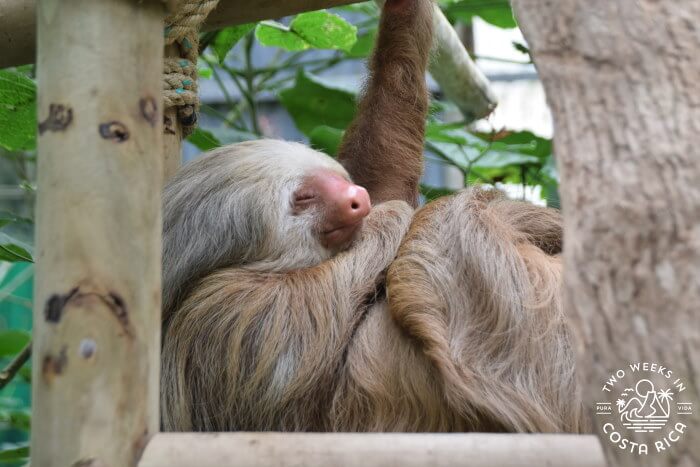
Orientation
Location
Selvatura Park is located just outside the town of Santa Elena in the region known as Monteverde. This area of Costa Rica is in the mountains northwest of San Jose and is best known for its vast cloud forest.
Because it is somewhat remotely located, Monteverde cannot easily be visited on a day trip from La Fortuna/Arenal Volcano or elsewhere. The town offers many activities, though, making it well worth a stop in your itinerary.
For more information about visiting, including other area activities, read our post, Monteverde: A Forest in the Clouds.
Selvatura Park
Selvatura Park has a large nature reserve with over 850 acres (344 hectares) of protected land. It borders the Monteverde Cloud Forest Reserve and another private reserve called Children’s Eternal Rainforest.
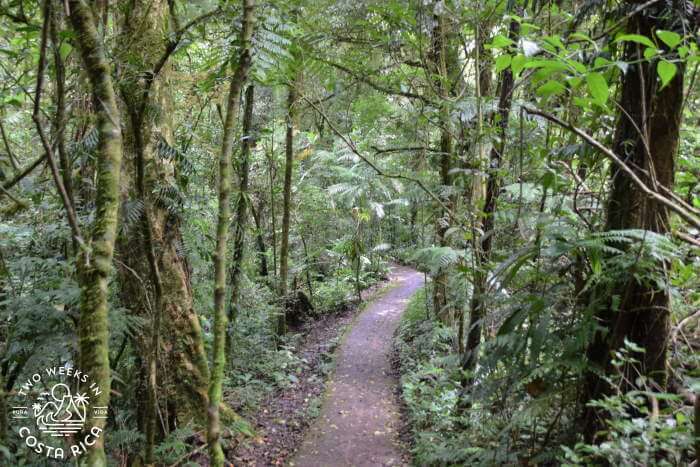
In addition to a hanging bridges tour through the cloud forest, Selvatura also offers zip lining and wildlife exhibits.
For wildlife exhibits, Selvatura has a butterfly garden and reptile exhibit. A couple of years ago they added the Sloth Sanctuary.
The Sloth Sanctuary Tour
Background
Our family recently took a tour of the Sloth Sanctuary.
The tour started at the main office where we met our guide, Juan Carlos, and gave him our tickets. He led us through the forest along the concrete path that goes to the hanging bridges. In just a few minutes, we arrived at the huge enclosure for the Sloth Sanctuary.

Passing through the doors, we noticed immediately that the temperature was much warmer. For the tropics, the climate in Monteverde is fairly cool (average temperature is around 21 °C/69 °F). But inside the closed in, greenhouse-like environment, it felt much warmer.
While sloths are native to the cooler climate of Monteverde, the sloths at Selvatura’s Sloth Sanctuary had previously lived in a warmer climate. A well-known wildlife rehabilitation center on the Caribbean coast called the Jaguar Rescue Center rescued them after they were injured or held illegally as pets. Unable to be released back into the wild, Selvatura now provides them with a comfortable home to live out the rest of their lives.
Seeing the Sloths
Right away after entering the enclosure, we saw a sloth almost at eye level. It was resting on a climbing ladder near the wall. The cuddly-looking animal was in the typical sloth position with its long arms and legs reaching up onto the ladder and its body hanging below. It had long, shaggy, beige-colored fur and a dark brown face and snout.

From Juan Carlos, we learned that this was a two-toed sloth. All the sloths in the enclosure were the two-toed species because they would not get along well with Costa Rica’s other variety of sloth, the three-toed sloth. Sloths are solitary animals. They are also territorial. So the ones we were seeing were only females, which get along better than a mix of males and females.
Juan Carlos started explaining more about Selvatura’s project and how it was conservation-based. We listened and watched in awe as another sloth cruised right above our heads. This one was rather speedy, crossing the path toward the first sloth we had seen. The two animals began disagreeing a bit through grunts over who should be in that spot. Then they separated without much drama.
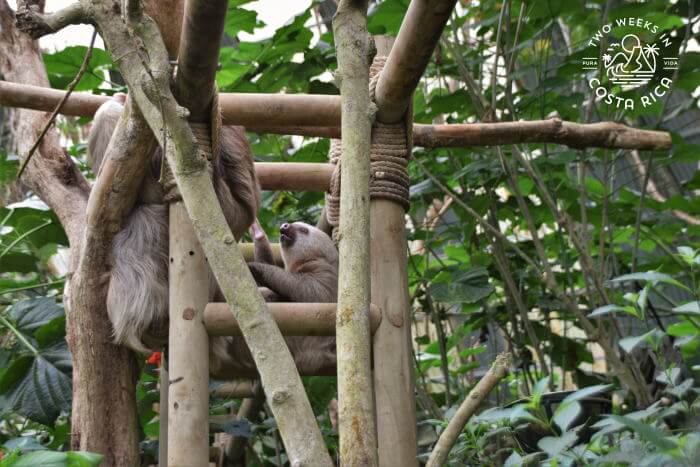
We learned that the enclosure was designed specifically as sloth habitat in an effort to mimic their natural environment. Thick rainforest filled the space. Short shrubby bushes and flowering plants, broad-leaf banana plants, and plenty of taller trees provided opportunities to climb.

Although two-toed sloths are one of the slowest mammals, when they want to move, they can actually go quite fast. Our guide explained that their light weight allows them to climb with ease. We watched this with several of the animals. They seemed to enjoy going up and down the ladder-like structures or trees and then curling up when they needed a break.
The path curved through the middle of the space. It was roped off, but we were still able to see the sloths fairly close up without stressing them out. Normally sloths spend their lives high up in treetop canopy, out of sight, so it was special to be able to watch them go about their daily lives, eating, climbing, and just relaxing.
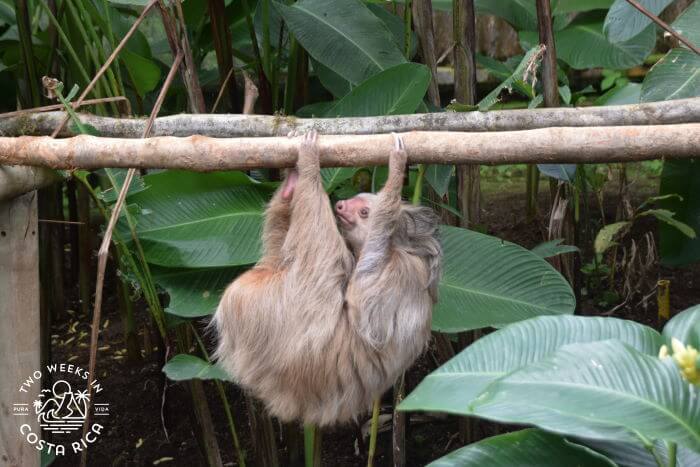
Learning About the Sloths
Our group learned a lot from our guide about the fascinating life of sloths, including some things we had never heard before during our travels in Costa Rica.
We knew that sloths lived in the trees, but learned that they mate and even give birth there as well. We also found out that although very slow on land, they are quite adept at swimming. Juan Carlos was very knowledgeable about these creatures and tried to keep us engaged, although we were all clearly distracted by the interesting behaviors of the sloths right in front of us.
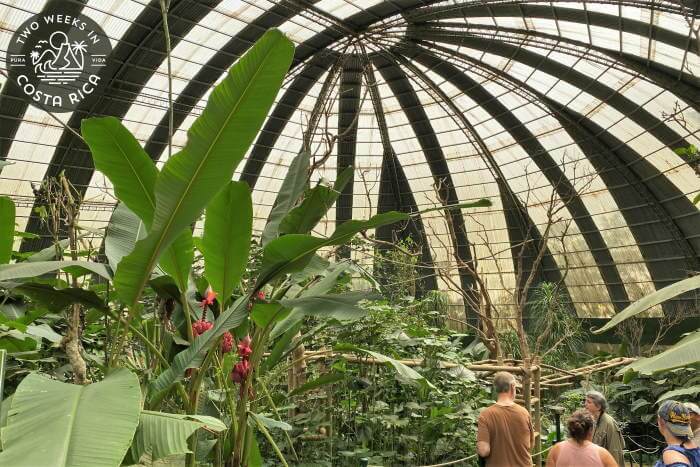
Other Sloth Exhibits in Costa Rica
Costa Rica does have other wildlife rehabilitation centers where you can see sloths up close, but Selvatura’s Sloth Sanctuary is different. It feels much more like the sloths are in the wild, since the enclosure is so large and full of greenery. At most other facilities, the animals are in much smaller spaces. It was great to see them living among so much rainforest.
In addition, the goal of the project is conservation. Some of the other sloth projects in Costa Rica seem to be driven by getting visitors and making money, rather than about the care and treatment of the animals.
Planning Your Visit to the Sloth Sanctuary
Times Offered
Tours of the Sloth Sanctuary are available daily at 8:30 a.m., 1:30 p.m., and 2:30 p.m.
All tours are guided; you cannot do a self-guided visit.
Getting Tickets
Individual tickets to the Sloth Sanctuary can be purchased directly through Selvatura’s website. But since Selvatura is a little far out, we recommend doing another tour while you’re there. Selvatura’s hanging bridges are some of our favorite in Costa Rica so a great add on. Feel free to reach out through the link below if you’d like help arranging a combo tour.
Sloth Sanctuary Tour
Cost: $39 per person adults. $35 per person students (up to age 18). $27 per person children ages 4-12. Rates plus 13% tax.
Duration: 45 minutes

Guided Hanging Bridges + Sloth Sanctuary
Cost: $104 per person adults; $93 per person students up to age 18 (ID required); $72 per person children ages 4-12. Rates plus 13% tax.
Duration: 3.5 hours
Conclusion
Spotting a sloth in the wild is special but being able to see one close up is truly unique. We highly recommend the Sloth Sanctuary to get that close-up view of these elusive animals. If you’re traveling with kids, it’s a nice activity since you are guaranteed to see wildlife. The tour is great for those adults too who are set on seeing a sloth during their trip.
Have you ever seen a sloth or visited a sloth sanctuary? Let us know in the comments below.
Looking for more information to plan your trip to Costa Rica? Check out these posts:
Monteverde Tours: Check out this list with more of our favorite tours in Monteverde/Santa Elena.
Manuel Antonio National Park: Hiking, Wildlife, and Beautiful Beaches – Manuel Antonio is one of the best places in Costa Rica to see a sloth in the wild. Check out our detailed guide about the town’s famous national park.
Monteverde Hotel Guide: Get recommendations for where to stay in Monteverde with this post.
Naturalist Guides in Costa Rica: When You Need Them and How to Find One – If you really want to see a sloth in the wild, it’s best to get a guide. They know where to find them and have powerful scopes that let you see them high in the trees. Learn about how to find a knowledgeable guide and what you’ll get out of a guided tour.


Your posts and recommendations are so helpful. We’ll be making our 3rd trip to CR soon to start looking for where we’d like to live. I’m grateful for you sharing your experiences and guidance!
You’re welcome, Cindy! Glad our posts have been helpful.
Matt & Jenn,
Most of the sloths I’ve seen in the wild have been on the Caribbean side (mostly 3-Toed) including multiple times at Hotel Banana Azul (Puerto Viejo) on their property and the beach road. Plus in nearby Cahuita is a fine Sloth Sanctuary with more than Jaguar Center had on that coast and in addition to their indoor tour of close encounters, they have a boat tour on a river behind their facility where you see sloths and other animals in the wild. Excellent! I’ve also seen the Two-toed Sloth in the wild in Tortuguero NP, Cahuita NP, and Gandoca-Manzanillo Wildlife Reserve. 🙂
In Central Valley I’ve seen them in the wild in Caño Negro, Braulio Carrillo NP near Tapirus Lodge, Monteverde Reserve, on Sarapiqui River, and at Chachagua Rainforest Lodge in San Ramon Canton.
On the South Pacific, my closest encounter and photos were from my room terrace at Cristal Ballena Hotel in Uvita, plus usually seen in walks through Manuel Antonio NP.
I have separate photo galleries for the 3-toed and the 2-toed at:
https://charliedoggett.smugmug.com/OTHER-WILDLIFE/Mammals-28-Species/Brown-throated-Three-toed-Sloth/
https://charliedoggett.smugmug.com/OTHER-WILDLIFE/Mammals-28-Species/Hoffmans-Two-toed-Sloth/
¡Pura vida! ~Charlie
We saw several sloths in the wild at Manuel Antonio National Park. We felt particularly lucky since one was walking on the ground and we were informed by the guide it’s pretty rare to catch that.
Hi Karen, It is rare to see them on the ground. They only come down from the tree about once a week to do their business. Lucky indeed!
Thank you! I love the sloths.
My family of 3 is traveling to Monteverde in a few weeks. How far in advance would you recommend booking guided tours, etc.
Hi Eli, We’d start booking anything you know you want to do now. It can take a while to hear back from tour operators. We wouldn’t wait until you arrive since it can be stressful arranging things last minute and the good guides/companies may not be available anymore.
We stayed at La Guayaba, a very tiny (3 rooms) lodge. It was fabulous!! Here is the review I posted on Booking.com:
Where to begin?? Ernesto and wife (and Nina the cat) were amazing hosts!!! From meeting us at our car to scheduling and confirming a night hike and transportation (bus-boat-bus) to Arenal, to pleasant conversations and impeccable service, he was the best proprietor I’ve ever met! This small, quaint hotel (3 rooms), is set right on the edge of town, very easy to get around on foot. Very comfy room, bed and private bath. The landscaping is so Tico with beautiful flowers and plants. Did I mention Nina? She welcomed us from our first arrival to our last. Beautifully laid table for the cooked to order breakfast, fresh juice and great coffee were an added bonus! Would revisit!
Hi Lisa, La Guayaba looks like a great option in Monteverde. Thanks for sharing your experience!
Is it necessary to always do tours? I am a very experienced hiker and have worked as a ranger in Yellowstone and other American national parks. I’d like to do some hiking in the cloud forests on my own. Is this not allowed? All I read about is tours and guides.
Thanks!
Hi Sylvan, You don’t always have to do a tour but you will appreciate the ecosystem so much more with a good naturalist guide. In Monteverde, we always recommend doing one guided hike to learn more about the cloud forest. It’s harder to see wildlife there so a good guide will help you spot more and also teach you a lot.